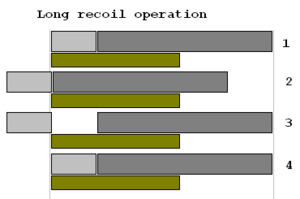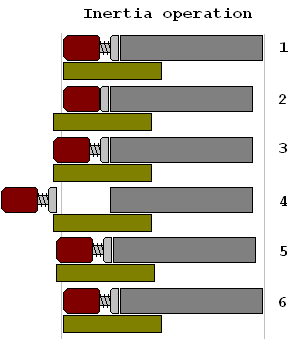Recoil operation facts for kids
Recoil operation is a clever way that some automatic firearms, like pistols and shotguns, use their own power to reload themselves after each shot. Instead of needing you to pull a lever or pump a handle, the gun uses the "kick" or recoil from firing a bullet to get ready for the next one. This is different from other types of guns that might use gas from the shot or just the pressure of the bullet leaving the barrel to reload.
Contents
History of Recoil Operation
The idea of using recoil to help reload a gun might have first appeared way back in 1663! An Englishman named Palmer supposedly thought of it, but it's hard to find proof. For a long time, this idea didn't really go anywhere.
Then, in the 1800s, things changed. People started making cartridges that held the bullet and gunpowder all in one easy-to-use package. This made recoil-operated guns much more practical.
- In 1855, Joseph Whitworth in Britain suggested using recoil to partly open a rifle's breech (the back part of the barrel).
- In 1862, Alexander Blakely clearly described using the recoil of a fired cannon to open its breech.
- Denmark started working on a recoil-reloading gun in 1864, but a working model wasn't ready until 1888.
- In the 1870s, a Swedish captain named D. H. Friberg patented a design for a fully automatic recoil-operated machine gun.
- Finally, in 1883, Hiram Maxim created his famous automatic recoil-operated machine gun. This invention truly started the modern age of automatic machine guns.
How Recoil Operation Works
When a firearm is fired, the bullet and hot gases shoot out of the barrel in one direction. Because of a rule in physics called the conservation of momentum, the gun itself must move in the opposite direction. This backward movement is called recoil.
In recoil-operated firearms, only a part of the gun moves backward, not the whole thing. Another part stays still, held by something like the ground or your hands. These moving and still parts are connected by a spring. The spring soaks up the recoil energy as it gets squeezed. Then, it expands, using that stored energy to help the gun reload itself.
For a recoil-operated gun to work, the bullet's cartridge must create enough recoil to move the parts. This means these guns work best with cartridges that match the design. For example, a M1911 pistol works best with a specific type of bullet. If you change the bullet type or use blank ammunition (which has no bullet), the gun might not reload correctly unless it has a special device to help.
Types of Recoil Operation
Recoil-operated designs are generally grouped by how their parts move when the gun fires.
Long Recoil System
Long recoil operation is mostly found in shotguns, especially those based on John Browning's Auto-5 design.
In a long recoil system, the barrel and the bolt (the part that loads the bullet) stay locked together. When the gun fires, they both move all the way backward, squeezing their springs. Once they reach the back, the bolt stays put. The barrel then moves forward by itself, pushed by its spring. As the barrel moves forward, the empty shell is pulled out and thrown away. A new shell from the magazine is then moved into place. Finally, the bolt is released and snaps forward, loading the new shell into the barrel.
This system was very popular for automatic shotguns for many years. Even though Browning stopped making the Auto-5 in 1999, some companies like Franchi still make shotguns using this design.
- How it works
- Ready to fire: The bolt is locked to the barrel. Both are fully forward.
- Firing: The recoil pushes the bolt and barrel all the way to the back. This squeezes their springs.
- Barrel moves forward: The bolt stays at the back. The barrel unlocks and moves forward, pushed by its spring. The empty shell is ejected.
- Bolt moves forward: The bolt then moves forward, pushed by its spring. It loads a new shell. The barrel locks into place as it returns to the front.
Short Recoil System
The short recoil system is very common in semi-automatic pistols that use powerful cartridges, like the 9mm. For smaller, less powerful pistol cartridges, a different system called blowback is usually used.
In short recoil, the barrel and bolt move backward together only a short distance. Then, they unlock and separate. The barrel stops quickly, but the bolt keeps moving backward. This movement squeezes the recoil spring and performs the actions of pulling out the empty shell and feeding a new one. As the bolt moves forward again, it locks back into the barrel and pushes the barrel back into its firing position.
There are many ways that the barrel and bolt lock and unlock in short recoil designs. The most common are the "tilting barrel" designs invented by John Browning, found in pistols like the M1911 and Hi Power. Other designs use different methods, like locking blocks or rotating barrels.
The very first machine gun, the Maxim gun, also used a short recoil system. This shows how important this design has been in firearm history.
- How it works
- Ready to fire: The bolt is locked to the barrel. Both are fully forward.
- Firing: The bolt and barrel recoil backward a short distance while locked together. Then, they unlock.
- Bolt moves back: The barrel stops, but the unlocked bolt keeps moving backward. It ejects the empty shell and squeezes the recoil spring.
- Bolt moves forward: The bolt moves forward, pushed by its spring. It loads a new shell into the barrel.
- Barrel locks: The bolt locks into the barrel and pushes the barrel back into its firing position.
Inertia System
The inertia system is another type of recoil operation. It was first used in the Sjögren shotgun in the early 1900s. In this system, almost the entire gun acts as the recoiling part, while only the bolt stays still when fired. Because of this, the inertia system is mainly used in guns that have a strong recoil, especially shotguns.
A similar inertia system was developed by Paolo Benelli in the 1980s. Most inertia-operated firearms made until recently were either by Benelli or used their design. Then, Browning Arms Company introduced their own inertia-operated shotgun, the A5. Both Benelli and Browning systems use a rotating bolt that locks into place, similar to many gas-operated firearms.
Before firing, a stiff spring separates the bolt body from the locked bolt head. When the shotgun fires and recoils, the bolt body is heavy enough to stay still for a moment. This movement squeezes the spring between the bolt head and bolt body, storing the energy needed to reload the gun. This system can handle many different types of shotgun shells, from standard to powerful ones.
It's important that the shotgun is free to recoil for this system to work. Your body's slight movement when you shoot is usually enough. But if you fire the shotgun from a very secure position, like resting it on the ground, it might not recoil enough to work properly. Also, adding too much weight to the gun can stop the system from working.
As the squeezed spring expands, it pushes the bolt body backward with enough force to reload the gun. The bolt body unlocks and pulls back the bolt head, which extracts and ejects the empty shell. It also cocks the hammer and squeezes the return spring. Once the bolt reaches the end of its travel, the return spring pushes it forward. This chambers the next round from the magazine and locks the bolt closed.
- How it works
- Ready to fire: The bolt is locked to the barrel. Both are fully forward.
- Firing: The gun recoils backward into the shooter's body. A heavy part (inertial mass) stays still for a moment, squeezing a spring. The bolt stays locked to the barrel.
- Energy transfer: The squeezed spring pushes the inertial mass backward. This transfers its energy to the bolt.
- Bolt moves back: The bolt unlocks and moves backward. It ejects the fired shell and squeezes the return spring.
- Bolt moves forward: The bolt moves forward, pushed by its spring. It loads a new shell and locks into place.
- Ready again: The shooter recovers from the shot, moving the gun forward for the next shot.
Muzzle Booster
Some short-recoil firearms, like the German MG 42 machine gun, use a special part at the end of the barrel called a muzzle booster. This device uses some of the energy from the escaping gases to push the barrel backward. This extra push helps the gun fire faster or work more reliably.
Muzzle boosters are also used on some suppressors (devices that make guns quieter). They help make up for the extra weight the suppressor adds to the recoiling parts. They also help recoil-operated guns work correctly with blank rounds (which have no bullet).
Automatic Revolvers
Some revolvers also use recoil to help them work. In these designs, the barrel and the cylinder (where the bullets are) are on an upper frame that recoils backward on top of a lower frame. As the upper part recoils, the cylinder turns to the next bullet, and the hammer is cocked. These actions are usually done by hand on most revolvers. Famous examples include the Webley–Fosbery and Mateba.
Other Autoloading Systems
Besides recoil operation, other systems are used to make firearms reload automatically:
- Delayed blowback firearms delay the bolt from opening until the gas pressure is safe enough to remove the empty shell.
- Blow forward firearms don't have a bolt. Instead, the barrel moves forward, pulled by the bullet, to reload the gun.
- Blowback firearms use the pressure of the expanding gas directly on the cartridge to push the bolt backward.
- Gas-operated firearms take a small amount of the expanding gas to power the moving parts that reload the gun.
See also
- Bump stock
- Slamfire






